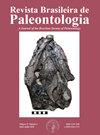Isotopic paleoecology (δ13C, δ18O) of a late Pleistocene vertebrate community from the Brazilian Intertropical Region
IF 0.6
4区 地球科学
Q4 PALEONTOLOGY
引用次数: 21
Abstract
Isotopes are one of the best tools to reconstruct the paleoecology of extinct taxa, allowing us to evaluate their diet (through carbon; C3 and C4 plants), their niche breadth (BA) and the environment in which they lived. In the present work we go deeper in the use of isotopes, and explore a mathematical mixing model with the stable isotopic composition of one (carbon) and two elements (carbon and oxygen) to evaluate (i) the relative contributions of three types of food resources (leaves, fruits and C4 grass) for meso- and megaherbivores (body mass > 100 kg) that lived during the late Pleistocene in Sergipe, Brasil, and (ii) which of these herbivores (together with some faunivorous taxa) could be potential preys for Smilodon populator and Caiman latirostris. Finally, we reconstructed the paleoenvironment in which the vertebrate community of Sergipe lived and concluded that the environment of Sergipe was a closer and drier landscape than African savannah nowadays, at least between 27 ka to 11 ka. Keywords: Quaternary, mammals, paleoecology, South America, stable isotopes. Isotopos sao uma das melhores ferramentas para reconstruir a Paleoecologia de taxons extintos, permitindo sugerir dieta (por meio do carbono, plantas C3 e C4), o nicho ecologico (BA) e ambiente em que viveram. No presente artigo nos aprofundamos no uso dos isotopos, e exploramos um modelo matematico misto com um isotopo (carbono) e dois isotopos (carbono e oxigenio) (i) para sugerir tres recursos tipos de recursos alimentares (folhas, frutas e gramineas C4) para meso-megaherbivoros (massa corporal acima de 100 kg) que viveram no Pleistoceno final de Sergipe, Brasil, e (ii) qual desses herbivoros (juntamente com faunivoros) foram presas potenciais de Smilodon populator e Caiman latirostris. Por fim, reconstruimos o paleoambiente na qual a comunidade de vertebrados de Sergipe viveu, concluindo que eramais fechada e seca do que as savanas da Africa atualmente, pelo menos entre 27 mil a 11 mil anos atras. Palavras-chave: Quaternario, paleoecologia, America do Sul, isotopos estaveis.巴西热带地区晚更新世脊椎动物群落的同位素古生态(δ13C, δ18O
同位素是重建已灭绝分类群古生态的最佳工具之一,使我们能够评估它们的饮食(通过碳;C3和C4植物)、生态位宽度(BA)和生存环境。在本研究中,我们深入研究了同位素的使用,并探索了一个含有一种(碳)和两种元素(碳和氧)稳定同位素组成的数学混合模型,以评估(i)生活在巴西Sergipe晚更新世的中、巨型食草动物(体重100公斤)的三种食物资源(树叶、水果和C4草)的相对贡献;(ii)这些食草动物(连同一些动物性类群)中哪些可能成为剑齿虎和凯门鳄的潜在猎物。最后,我们重建了Sergipe地区脊椎动物群落生活的古环境,并得出结论:至少在27 ka至11 ka之间,Sergipe地区的环境比现在的非洲大草原更接近、更干燥。关键词:第四纪,哺乳动物,古生态学,南美洲,稳定同位素在古生态学中发现了灭绝分类群的同位素,允许糖源(碳源,植物C3和C4)和nico生态学(BA)的存在。No presente artigo nos aprofundamos No uso dos isotopos, e exploramos um modelo matematico misto com um isotopos (carbono) e dois isotopos (carbono e oxigenio) (i) para sugerir treres recursos tipos de recursos alimentares (folhas, frutas e gramineas C4) para meso-megaherbivoros (massa corporal acima de 100 kg) que viveram No Pleistoceno final de Sergipe, brazil) (ii) qualdeses herbivoros (juntamente com faunivoros) foram presas potenciais de Smilodon populator e Caiman latirostris)。最后,对古环境的重建,相当于对Sergipe viveus的脊椎动物群落的重建,结论是对非洲热带草原的重建,以及对非洲自然环境的重建,以及对非洲热带草原的重建。古生物学:第四纪,古生态学,南美洲,同位素。
本文章由计算机程序翻译,如有差异,请以英文原文为准。
求助全文
约1分钟内获得全文
求助全文
来源期刊

Revista Brasileira De Paleontologia
PALEONTOLOGY-
CiteScore
1.60
自引率
14.30%
发文量
25
审稿时长
>12 weeks
期刊介绍:
It publishes original contributions on all aspects of Paleontology. Papers are written in English, Spanish, or Portuguese and are reviewed by international experts.
 求助内容:
求助内容: 应助结果提醒方式:
应助结果提醒方式:


